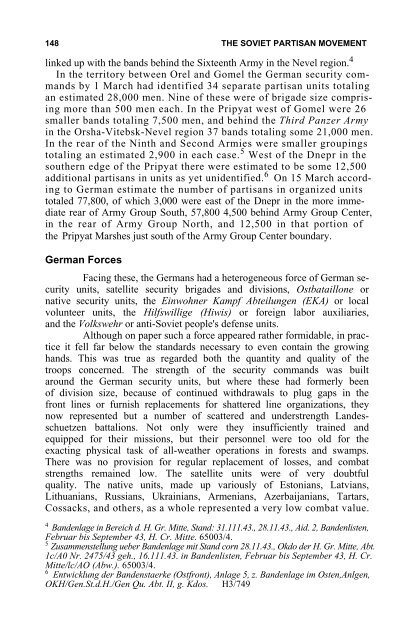the soviet partisan movement 1941-1944 by edgar m. howell
the soviet partisan movement 1941-1944 by edgar m. howell
the soviet partisan movement 1941-1944 by edgar m. howell
You also want an ePaper? Increase the reach of your titles
YUMPU automatically turns print PDFs into web optimized ePapers that Google loves.
148 THE SOVIET PARTISAN MOVEMENT<br />
linked up with <strong>the</strong> bands behind <strong>the</strong> Sixteenth Army in <strong>the</strong> Nevel region. 4<br />
In <strong>the</strong> territory between Orel and Gomel <strong>the</strong> German security commands<br />
<strong>by</strong> 1 March had identified 34 separate <strong>partisan</strong> units totaling<br />
an estimated 28,000 men. Nine of <strong>the</strong>se were of brigade size comprising<br />
more than 500 men each. In <strong>the</strong> Pripyat west of Gomel were 26<br />
smaller bands totaling 7,500 men, and behind <strong>the</strong> Third Panzer Army<br />
in <strong>the</strong> Orsha-Vitebsk-Nevel region 37 bands totaling some 21,000 men.<br />
In <strong>the</strong> rear of <strong>the</strong> Ninth and Second Armies were smaller groupings<br />
totaling an estimated 2,900 in each case. 5 West of <strong>the</strong> Dnepr in <strong>the</strong><br />
sou<strong>the</strong>rn edge of <strong>the</strong> Pripyat <strong>the</strong>re were estimated to be some 12,500<br />
additional <strong>partisan</strong>s in units as yet unidentified. 6 On 15 March according<br />
to German estimate <strong>the</strong> number of <strong>partisan</strong>s in organized units<br />
totaled 77,800, of which 3,000 were east of <strong>the</strong> Dnepr in <strong>the</strong> more immediate<br />
rear of Army Group South, 57,800 4,500 behind Army Group Center,<br />
in <strong>the</strong> rear of Army Group North, and 12,500 in that portion of<br />
<strong>the</strong> Pripyat Marshes just south of <strong>the</strong> Army Group Center boundary.<br />
German Forces<br />
Facing <strong>the</strong>se, <strong>the</strong> Germans had a heterogeneous force of German security<br />
units, satellite security brigades and divisions, Ostbataillone or<br />
native security units, <strong>the</strong> Einwohner Kampf Abteilungen (EKA) or local<br />
volunteer units, <strong>the</strong> Hilfswillige (Hiwis) or foreign labor auxiliaries,<br />
and <strong>the</strong> Volkswehr or anti-Soviet people's defense units.<br />
Although on paper such a force appeared ra<strong>the</strong>r formidable, in practice<br />
it fell far below <strong>the</strong> standards necessary to even contain <strong>the</strong> growing<br />
hands. This was true as regarded both <strong>the</strong> quantity and quality of <strong>the</strong><br />
troops concerned. The strength of <strong>the</strong> security commands was built<br />
around <strong>the</strong> German security units, but where <strong>the</strong>se had formerly been<br />
of division size, because of continued withdrawals to plug gaps in <strong>the</strong><br />
front lines or furnish replacements for shattered line organizations, <strong>the</strong>y<br />
now represented but a number of scattered and understrength Landesschuetzen<br />
battalions. Not only were <strong>the</strong>y insufficiently trained and<br />
equipped for <strong>the</strong>ir missions, but <strong>the</strong>ir personnel were too old for <strong>the</strong><br />
exacting physical task of all-wea<strong>the</strong>r operations in forests and swamps.<br />
There was no provision for regular replacement of losses, and combat<br />
strengths remained low. The satellite units were of very doubtful<br />
quality. The native units, made up variously of Estonians, Latvians,<br />
Lithuanians, Russians, Ukrainians, Armenians, Azerbaijanians, Tartars,<br />
Cossacks, and o<strong>the</strong>rs, as a whole represented a very low combat value.<br />
4<br />
Bandenlage in Bereich d. H. Gr. Mitte, Stand: 31.111.43., 28.11.43., Aid. 2, Bandenlisten, <br />
Februar bis September 43, H. Cr. Mitte. 65003/4.<br />
5<br />
Zusammenstellung ueber Bandenlage mit Stand corn 28.11.43., Okdo der H. Gr. Mitte, Abt. <br />
1c/A0 Nr. 2475/43 geh., 16.111.43. in Bandenlisten, Februar bis September 43, H. Cr. <br />
Mitte/lc/AO (Abw.). 65003/4.<br />
6<br />
Entwicklung der Bandenstaerke (Ostfront), Anlage 5, z. Bandenlage im Osten,Anlgen, <br />
OKH/Gen.St.d.H./Gen Qu. Abt. II, g. Kdos. H3/749
















